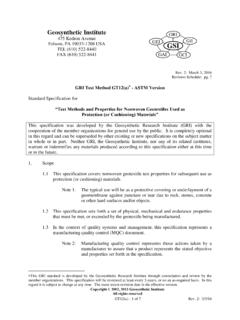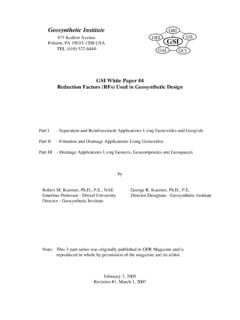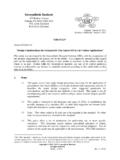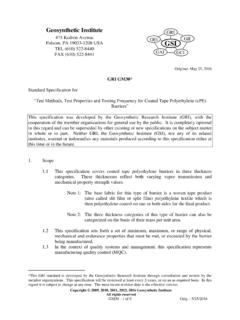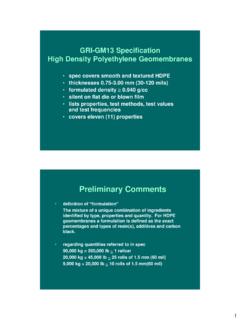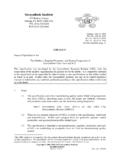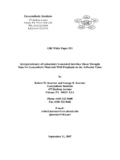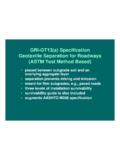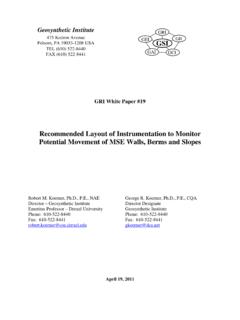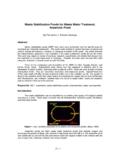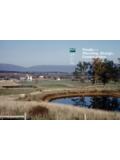Transcription of Geosynthetic Institute GRI GEI GII Folsom, PA …
1 GRI White Paper #15 Survey of State Regulations on Allowable Leakage Rates in Liquid Impoundments and Wastewater ponds by Robert M. Koerner and Jamie R. Koerner Geosynthetic Institute 475 Kedron Avenue Folsom, PA 19033 USA Phone: 610-522-8440 Fax: 610-522-8441 E-mails: May 6, 2009 Geosynthetic Institute 475 Kedron Avenue Folsom, PA 19033-1208 USA TEL (610) 522-8440 FAX (610) 522-8441 GSI GRI GII GAI GEI GCI GRI White Paper #15 Survey of U. S. State Regulations on Allowable Leakage Rates in Liquid Impoundments and Wastewater ponds Background Perhaps the greatest emphasis on leakage from geomembrane lined facilities has been with respect to leakage of leachate from solid waste landfills. Most national regulations have addressed (or struggled with) this situation.
2 In this regard all national regulations to our knowledge limit the maximum leachate head on the base geomembrane liner to 300 mm (12 inches). That said, the use of double lined systems allows for quantification of the leakage through the primary liner system. The following table gives insight into the various landfill leakage amounts and subsequent strategies that have been discussed by the U. S. EPA over the years. Various Leakage Amounts and Suggested Response Action Plans (RAP s) for Landfills [An approximate units conversion is 10 liters/hectare-day (lphd) = gallons/acre-day (gpad)] (a) de minimum leakage = 10 lphd (~ gpad) the vapor diffusion through perfect geomembrane with no flaws ranges from to 20 lphd (~ to gpad).
3 , this represents the perfect liner (b) typical action leakage rate (ALR) = 50 to 200 (~ to 20 gpad) continue monitoring assess liquid characteristics compare to primary leachate (c) typical intermediate leakage rate (ILR) = 200 to 1000 (~ 20 to 100 gpad) stop adding waste continue monitoring and testing of liquid characteristics (d) typical rapid and large leak (RLL) > 1000 lphd (> 100 gpad) remove the overlying waste repair leak(s) Note: All of the above RAP-values are for illustration only; they must be site specifically determined. Also note that the EPA only requires the establishment of an action leakage rate (ALR) value. Contrasting liquid impoundments (such as ponds , lagoons, reservoirs, trenches, basins, etc.)
4 To solid waste landfills, the hydraulic head is site specific and can be quite high. It is invariably much greater than 200 mm (12 inches). Thus, for a given number of leaks and their respective sizes, the seepage from a liquid impoundment will be much greater than with a solid waste landfill at such low value of hydraulic head. The following table indicates how leakage increases as the hydraulic head above the liner increases. Also the type of liner system (geomembrane by itself, or geomembrane over clay or GCL) is important. The data clearly indicates this to be the case. The data also indicates that, depending on site-specific conditions, the leakage can be enormous. It is potentially so high that various governmental agencies have recommended guidance as to maximum leakage allowed from various types of liquid impoundments and wastewater ponds .
5 This survey is intended to report the state-of-the-practice insofar as regulatory guidance for maximum allowable leakage from liquid impoundments and wastewater ponds . Table 1 - Generalized Leakage Rates Through Liners (ref. Giroud and Bonaparte, Jour. G & G, 1989) Type of Leakage Liquid height on top of the geomembrane Liner Mechanism m m 3 m 30 m Geomembrane alone (between two sand layers) Diffusion Small Holes* Large Holes* 300 10,000 1 1,000 30,000 10 3,000 100,000 300 10,000 300,000 Composite liner (poor field conditions, , waves) Diffusion Small Holes* Large Holes* 1 1 6 7 100 50 60 300 400 500 Composite liner (good field conditions, , flat) Diffusion Small Holes* Large Holes* 1 1 100 9 11 300 75 85 Values of leakage rate are in lphd (values can be divided by approximately 10 to obtain values expressed in gpad) *assumes 3 holes/ha ( , hole/acre)
6 Survey Protocol and Tabulated Results The question of maximum allowable leakage from a liquid impoundments and wastewater ponds , whether they be unlined or lined, is quite common. Of course, the amount is related to the environmental consequences of the escaping liquid, but it should nevertheless be a quantified value. All fifty states in the USA were investigated and most of the resulting information gathered was from their Internet websites since they are common to most agencies. That said, many state agencies were contacted directly so as to properly interpret their requirements. Ultimately, the regulations of thirty-seven state agencies (74% response) are included in the results. Regarding the nature of the various liquids being impounded, the following was determined insofar as states having such regulations, even though not all states specify allowable leakage rates.
7 Sewage and/or wastewater ponds - 19 (48%) States have regulations Other liquid impoundments - 9 (18%) States have regulations Municipal and Industrial Lagoons - 2 States have regulations Livestock waste control - 2 States have regulations Earthen impoundments - 1 State has regulations In-situ leach mines - 1 State has regulations Metal laden seepage water - 1 State has regulations General aquifer - 1 State has regulations Leakage collection pond - 1 State has regulations States that do not specify leakage rate in regulations - 9 (18%) States have regulations Table 2 lists each governmental agency and the type of liquid impoundment from which the above tabulation was obtained. The leakage as specifically stated in the regulations is given and then the value was converted to the common unit of gallons per acre per day, or gal/acre-day (gpad).
8 The tremendous variation between agencies is readily observed; , from 13 gpad-to-6800 gpad. Perhaps it is more revealing to separate the maximum allowable leakage rate by the type of liquid being impounded. In this regard, the following was determined. Sewage/wastewater ponds from 13 to 3400 gal/acre-day Other liquid impoundments Livestock waste control from 3400 to 6800 gal/acre-day Municipal and Industrial Lagoons from 1700 to 3400 gal/acre-day Earthen impoundments 13 gal/acre-day In-situ leach mines 1700 gal/acre-day Metal laden seepage water 480 gal/acre-day General aquifer 550 gal/acre-day Leakage collection pond 200 gal/acre-day It should be noted that there does exist an Interagency Wastewater Committee of the Great Lakes/Upper Mississippi River Board of State and Provincial Public Health and Environmental Managers.
9 Their members are Illinois, Indiana, Iowa, Michigan, Minnesota, Missouri, New York, Ohio, Ontario, Pennsylvania and Wisconsin. The value of maximum leakage that has been set for wastewater collection and treatment facilities is 500 gal/acre-day. Table 2 - Allowable Leakage Rates in Reservoirs and ponds STATE AGENCY TYPE OF IMPOUNDMENT LEAKAGE IN REGULATIONS LEAKAGE IN GAL/ACRE-DAY metal laden seepage water pond 10-6 gal/min/ft2 480 gal/acre-day Alaska DEC - Division of Water wastewater treatment lagoon < 500 gal/acre-day 500 gal/acre-day Arizona DEQ - Groundwater general aquifer < 550 gal/acre-day 550 gal/acre-day Arkansas DEQ -GL/UM River Board* wastewater storage ponds < 500 gal/acre-day 500 gal/acre-day California Lagoon and Pond Require.
10 Lagoons and retention ponds do not specify leakage rate n/a Colorado Water Quality Control sewage ponds <10-6 cm/sec or permit is required 125 gal/acre-day Delaware EPA- Water Pollution reservoirs and ponds do not specify leakage rate n/a Florida - GL/UM River Board* storage ponds lined to prevent measurable seepage 500 gal/acre-day Georgia DNR - Engineering preapplication treatment ponds 1/8 inch per day 3400 gal/acre-day Great Lakes/Upper Mississippi River Board wastewater storage ponds < 500 gal/acre-day 500 gal/acre-day Idaho Water Allocation Bureau reservoirs and ponds do not specify leakage rate n/a Illinois NRCS waste storage ponds < 1X10-7 cm per sec 13 gal/acre-day Indiana DNR - Division of Water wastewater storage ponds < 550 gal/acre-day 550 gal/acre-day Iowa DNR - Wastewater municipal and industrial lagoons 1/16 inch per day at a water depth of 6 ft.
